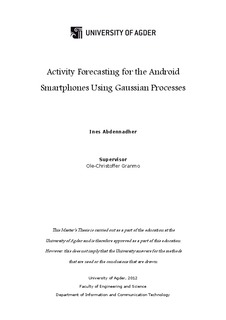| dc.description.abstract | Smartphones have become amazingly popular the last few years, most likely due to the
operating system revolution that has taken place, in particular when it comes to the
introduction of sophisticated applications. The Android operating system is nowadays known
by the most famous and used one thanks to the new and multiple functionalities it offers.
Despite the advantages of this revolution, it has come with a high cost: The level of
sophistication and the multiple functions now offered typically rely on high quality screen,
intensive CPU usage, and extensive networking. As a result, power consumption increases
persistently, hindering further advances and lead to a short battery life time. So, techniques
for predicting the future behavior of the Android phone are needed and can serve as a basis
for power management.
The present Master’s thesis seeks to develop a better understanding of how machine
learning can be efficient and useful to predict the future behavior of the smartphone. Two
learning approaches KNN Regression and Gaussian Process Regression are used to do the
forecast of the CPU usage, the screen utilization and the network activity based on historical
collected measurements of these three components. The results reveal that the Gaussian
Process Regression model is most efficient and accurate than the KNN regression model with
a prediction error rate between 1% and 7%. By using the Gaussian Process Regression
model, it becomes possible to apply power management techniques to smartphones. In fact,
by predicting the future inactivity periods and the idle states of the phone, components of
the smartphone can be turned off in the right time and then avoid extensive switching
between on- and off-modus, which is expensive in itself and consumes too much power; or
by reducing the CPU frequency, disconnecting the phone from the network and adjusting the
screen quality to be less bright in idle mode, battery power consumption can be significantly
reduced. | no_NO |
